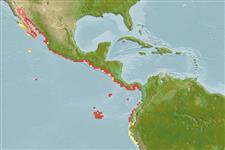Environment: milieu / climate zone / Tiefenbereich / distribution range
Ökologie
seewasser riff-verbunden; tiefenbereich 10 - 60 m (Ref. 91172). Tropical; 33°N - 12°S, 115°W - 78°W (Ref. 55)
Eastern Pacific: Mexico to Peru.
Length at first maturity / Size / Gewicht / Alter
Geschlechtsreife: Lm 26.4, range 17 - 18 cm
Max length : 105 cm TL Männchen/unbestimmt; (Ref. 106806); max. veröff. Gewicht: 1.3 kg (Ref. 40637)
Rückenflossenstacheln (insgesamt) : 10; Rückenflossenweichstrahlen (insgesamt) : 12 - 13; Afterflossenstacheln: 3; Afterflossenweichstrahlen: 8. Preopercular notch and knob weak. Scale rows on back rising obliquely above the lateral line. Pale crimson on side, often with silvery sheen of horizontal rows of bluish spots; belly golden yellow. Head with bluish spots and irregular broken lines, especially across cheek. A large blackish blotch on the upper back below the posterior of the dorsal spines.
Body shape (shape guide): fusiform / normal; Cross section: oval.
Adults are found over hard bottoms in inshore reef areas. Generally solitary or in small groups but may occasionally form big schools (Ref. 9313). Juveniles inhabit estuaries and mouths of rivers (Ref. 9313). Carnivorous, feed on invertebrates and fish (Ref. 9313). Marketed fresh or frozen (Ref. 9313).
Allen, G.R., 1985. FAO Species Catalogue. Vol. 6. Snappers of the world. An annotated and illustrated catalogue of lutjanid species known to date. FAO Fish. Synop. 125(6):208 p. Rome: FAO. (Ref. 55)
IUCN Rote Liste Status (Ref. 130435: Version 2025-1)
Bedrohung für Menschen
Harmless
Nutzung durch Menschen
Fischereien: kommerziell; Sportfisch: ja
Tools
Zusatzinformationen
Download XML
Internet Quellen
Estimates based on models
Preferred temperature (Ref.
123201): 22.3 - 29.1, mean 26.2 °C (based on 214 cells).
Phylogenetic diversity index (Ref.
82804): PD
50 = 0.5000 [Uniqueness, from 0.5 = low to 2.0 = high].
Bayesian length-weight: a=0.01349 (0.00851 - 0.02138), b=2.91 (2.78 - 3.04), in cm total length, based on LWR estimates for this species & Genus-body shape (Ref.
93245).
Trophic level (Ref.
69278): 4.0 ±0.2 se; based on diet studies.
Widerstandsfähigkeit (Ref.
120179): mittel, Verdopplung der Population dauert 1,4 - 4,4 Jahre. (K = 0.19; Fec = 66,400).
Prior r = 0.57, 95% CL = 0.37 - 0.85, Based on 1 data-limited stock assessment.
Fishing Vulnerability (Ref.
59153): Low to moderate vulnerability (35 of 100).
🛈
Nutrients (Ref.
124155): Calcium = 28.4 [17.6, 41.8] mg/100g; Iron = 0.327 [0.204, 0.502] mg/100g; Protein = 18.8 [17.3, 20.2] %; Omega3 = 0.127 [0.086, 0.183] g/100g; Selenium = 71.2 [46.4, 111.1] μg/100g; VitaminA = 88 [17, 326] μg/100g; Zinc = 0.362 [0.282, 0.513] mg/100g (wet weight);
